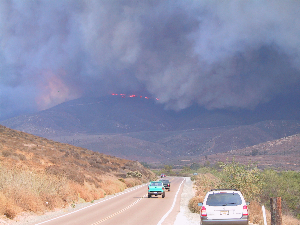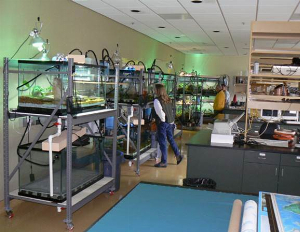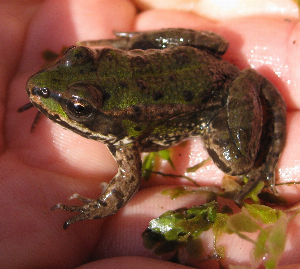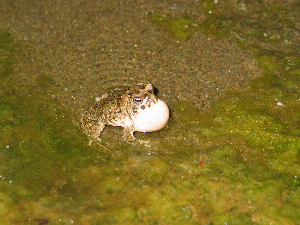Search ARMI Database
Search term(s)
Contribution Number
Search Results
106 record(s) found.
Papers & Reports Setting priorities for private land conservation in fire-prone landscapes: Are fire risk reduction and biodiversity conservation competing or compatible objectives?
Authors: A D Syphard; Van Butsic; Avi Bar-Massada; J E Keeley; J Tracey; Robert N Fisher
Date: 2016 | Outlet: Ecology and Society 21(3):2.
Although wildfire plays an important role in maintaining biodiversity in many ecosystems, fire management to protect human assets is often carried out by different agencies than those tasked for conserving biodiversity. In fact, fire risk reduction and biodiversity conservation are often viewed as competing objectives. Here we explored the role of management through private land conservation and asked whether we could identify private land acquisition strategies that fulfill the mutual objectives of biodiversity conservation and fire risk reduction, or whether the maximization of one objective comes at a detriment to the other. Using a fixed budget and number of homes slated for development, we simulated 20 years of housing growth under alternative conservation selection
strategies, and then projected the mean risk of fires destroying structures and the area and configuration of important habitat types in San Diego County, California, USA. We found clear differences in both fire risk projections and biodiversity impacts based on the way conservation lands are prioritized for selection, but these differences were split between two distinct groupings. If no conservation lands were purchased, or if purchases were prioritized based on cost or likelihood of development, both the projected fire risk and biodiversity impacts were much higher than if conservation lands were purchased in areas with high fire hazard or high species richness. Thus, conserving land focused on either of the two objectives resulted in nearly equivalent mutual benefits for both. These benefits not only resulted from preventing development in sensitive areas, but they were also due to the different housing patterns and arrangements that occurred as development was displaced from those areas. Although biodiversity conflicts may still arise using other fire management strategies, this study shows that mutual objectives can be attained through land-use planning in this region. These results likely generalize to any place where high species richness overlaps with hazardous wildland vegetation.
strategies, and then projected the mean risk of fires destroying structures and the area and configuration of important habitat types in San Diego County, California, USA. We found clear differences in both fire risk projections and biodiversity impacts based on the way conservation lands are prioritized for selection, but these differences were split between two distinct groupings. If no conservation lands were purchased, or if purchases were prioritized based on cost or likelihood of development, both the projected fire risk and biodiversity impacts were much higher than if conservation lands were purchased in areas with high fire hazard or high species richness. Thus, conserving land focused on either of the two objectives resulted in nearly equivalent mutual benefits for both. These benefits not only resulted from preventing development in sensitive areas, but they were also due to the different housing patterns and arrangements that occurred as development was displaced from those areas. Although biodiversity conflicts may still arise using other fire management strategies, this study shows that mutual objectives can be attained through land-use planning in this region. These results likely generalize to any place where high species richness overlaps with hazardous wildland vegetation.
Papers & Reports Mapping habitat for multiple species in the Desert Southwest.
Authors: R D Inman; K E Nussear; T C Esque; A G Vandergast; Stacie A Hathaway; D A Wood; Kelly R Barr; Robert N Fisher
Date: 2014 | Outlet: U.S. Geological Survey Open-File Report 2014-1134, pp. 92
Many utility scale renewable energy projects are currently proposed across the Mojave Ecoregion. Agencies that manage biological resources throughout this region need to understand the potential impacts of these renewable energy projects and their associated infrastructure (for example, transmission corridors, substations, access roads, etc.) on species movement, genetic exchange among
populations, and species’ abilities to adapt to changing environmental conditions. Understanding these
factors will help managers select appropriate project sites and possibly mitigate for anticipated effects of management activities. We used species distribution models to map habitat for 15 species across the Mojave Ecoregion to aid regional land-use management planning. Models were developed using a common 1 × 1 kilometer resolution with maximum entropy and generalized additive models. Occurrence data were compiled from multiple sources, including VertNet (http://vertnet.org/index.php), HerpNET (http://www.herpnet.org), and MaNIS (http://manisnet.org), as well as from internal U.S. Geological Survey databases and other biologists. Background data included 20 environmental covariates representing terrain, vegetation, and climate covariates. This report summarizes these environmental covariates and species distribution models used to predict habitat for the 15 species across the Mojave Ecoregion.
populations, and species’ abilities to adapt to changing environmental conditions. Understanding these
factors will help managers select appropriate project sites and possibly mitigate for anticipated effects of management activities. We used species distribution models to map habitat for 15 species across the Mojave Ecoregion to aid regional land-use management planning. Models were developed using a common 1 × 1 kilometer resolution with maximum entropy and generalized additive models. Occurrence data were compiled from multiple sources, including VertNet (http://vertnet.org/index.php), HerpNET (http://www.herpnet.org), and MaNIS (http://manisnet.org), as well as from internal U.S. Geological Survey databases and other biologists. Background data included 20 environmental covariates representing terrain, vegetation, and climate covariates. This report summarizes these environmental covariates and species distribution models used to predict habitat for the 15 species across the Mojave Ecoregion.
Papers & Reports Chapter D. Summary and conclusions.
Authors: R Schroeder; Elizabeth A Gallegos; G Smith; P Martin; Robert N Fisher
Date: 2015 | Outlet: U.S. Geological Survey Scientific Investigations Report pp 97-106
Hydrological and biological investigations were done during 2005 and 2006 in cooperation with the U.S. National Park Service at Darwin Falls in Death Valley National Park, Piute Spring in Mojave National Preserve, and Fortynine Palms Oasis in Joshua Tree National Park where discharge from springs or groundwater seeps sustains rare perennial streams in the otherwise arid environment of the Mojave Desert in which surface water is scarce and usually ephemeral. The study collected data on water quantity (discharge), temperature, water quality, and endemic anuran (frog and toad) populations and their health. In addition, a single survey of endemic anuran populations and their health was completed at Rattlesnake Canyon in the Joshua Tree National Park. Results from this study were compared to historical data, and can provide a baseline for future hydrological and biological investigations to evaluate health and sustainability of the resource as well as its response to changing climate and increases in human use.
Papers & Reports Chapter C. Anuran abundance and health at selected springs in the Mojave network parks.
Authors: Elizabeth A Gallegos; Robert N Fisher
Date: 2015 | Outlet: U.S. Geological Survey Scientific Investigations Report pp. 77-95
Data collected from the biological surveys completed for this study were evaluated to document the reproduction, estimate the population, and assess the overall health of each of the endemic anuran species present at the Darwin Falls, Piute Spring, and Fortynine Palms Oasis study areas. Where available, historical biological data also were evaluated.
Papers & Reports Conservation and recovery of the mountain yellow-legged frog in southern California, USA.
Authors: Adam R Backlin; Elizabeth A Gallegos; Robert N Fisher
Date: 2012 | Outlet: Global Re-introduction perspectives:2011, more case studies from around the globe, Soorae, P.S., ed. Re-introduction specialist Group and Abu Dhabi, UAE: Environment Agency-Abu Dhabi. Gland, Switzerland pp. 77-80
Papers & Reports Chapter 6. Voucher specimens: Appendix C. Field parasitology techniques for reptile surveys.
Authors: S L Gardner; Robert N Fisher; Sean J Berry
Date: 2012 | Outlet: Reptile Biodiversity: Standard Methods of Inventory and Monitoring
Studies of the systematics and ecological characteristics of hosts and their parasites require proper identification of both groups. When the parasites associated with a host are not collected
and preserved properly, species- level diagnostic characters (i.e., morphological characters) are usually destroyed. In addition, improper preservation of parasites severely limits,
or more likely prevents, studies based on DNA from those specimens.
and preserved properly, species- level diagnostic characters (i.e., morphological characters) are usually destroyed. In addition, improper preservation of parasites severely limits,
or more likely prevents, studies based on DNA from those specimens.
Papers & Reports Chapter 4. Planning and associated data: Data quality assurance and quality control.
Authors: A Atkinson; Carlton J Rochester; Robert N Fisher
Date: 2012 | Outlet: Reptile Biodiversity: Standard Methods of Inventory and Monitoring
Papers & Reports Chapter 4. Planning and associated data: Databases, metadata, and integrated data management.
Authors: Christopher W Brown; Robert N Fisher
Date: 2012 | Outlet: in: Reptile Biodiversity: Standard Methods of Inventory and Monitoring
One end goal of a study is to analyze and synthesize the data collected in an effort to understand their meaning. Most data from field studies are analyzed in an electronic format, using modern software packages for models and statistics. Consequently, how the data are stored is important and should be considered simultaneously with protocol development. Data definitions and data storage should reflect how the data are collected in the field and how they ultimately will be analyzed.
Papers & Reports Chapter 4. Planning and associated data: Handheld computers for digital data collection.
Authors: Carlton J Rochester; Robert N Fisher
Date: 2012 | Outlet: in: Reptile Biodiversity: Standard Methods of Inventory and Monitoring
Here, we describe an alternative to traditional penand-paper data recording. With recent advancements in handheld computers and their software applications, the development and use of electronic forms for recording data (using Personal Digital Assistants, or PDAs), a topic that has only been mentioned briefly in previous literature (e.g., Donnelly and Guyer 1994), has become a reality. Multiple operating platforms for PDAs, including handheld PCs, Pocket PCs, and the Palm OS (see Appendix II), are now on the market. Each one offers mobile, electronic data collection and its associated benefits to investigators in the fi eld. Below, we outline some of the advancements that have been made over the past 10 years in the use of PDAs for recording data, and we compare the benefits of recording field data electronically with those of data entry on paper sheets.
Papers & Reports Thamnophis hammondii (two-striped garter snake): Prey.
Authors: Edward L Ervin; S J Mullin; Robert N Fisher
Date: 2003 | Outlet: Herpetological Review 34(1):74-75
Papers & Reports Introduced parasites of freshwater fish in southern California, U.S.A.
Authors: B I Kuperman; V E Matey; M L Warburton; Robert N Fisher
Date: 2002 | Outlet: pp. 407-411 in: Proceedings of the 10th International Congress of Parasitology - ICOPA X. Monduzzi Editore S.p.A. - MEDIMOND Inc., Bologna, Italy. 660 pp.
Papers & Reports Thamnophis hammondii (two-striped garter snake): Prey.
Authors: Edward L Ervin; Robert N Fisher
Date: 2001 | Outlet: Herpetological Review 32(4):265-266
Papers & Reports Urban and suburban areas.
Authors: Robert N Fisher
Date: 2016 | Outlet: Habitat Management Guidelines for Amphibians and Reptiles of the Southwestern United States 154-157
Papers & Reports Chapter 2. Planning and setting objectives in field studies.
Authors: Robert N Fisher
Date: 2016
This chapter enumerates the steps required in designing and planning field studies on the ecology and conservation of reptiles, as these involve a high level of uncertainty and risk. To this end, the chapter differentiates between goals (descriptions of what one intends to accomplish) and objectives (the measurable steps required to achieve the established goals). Thus, meeting a specific goal may require many objectives. It may not be possible to define some of them until certain experiments have been conducted; often evaluations of sampling protocols are needed to increase certainty in the biological results. And if sampling locations are fixed and sampling events are repeated over time, then both study-specific covariates and sampling-specific covariates should exist. Additionally, other critical design considerations for field study include obtaining permits, as well as researching ethics and biosecurity issues.
Papers & Reports Chapter 9. Standard techniques for inventory and monitoring: Reptile sign and camera traps.
Authors: Robert N Fisher
Date: 2012 | Outlet: Reptile Biodiversity: Standard Methods of Inventory and Monitoring
Papers & Reports Chapter 9. Standard techniques for inventory and monitoring: Pitfall-trap surveys.
Authors: Robert N Fisher; Carlton J Rochester
Date: 2012 | Outlet: Reptile Biodiversity: Standard Methods of Inventory and Monitoring
Papers & Reports Chapter 3. Study design and sampling: Overview.
Authors: Robert N Fisher; M J Mitrovich
Date: 2012 | Outlet: Reptile Biodiversity: Standard Methods of Inventory and Monitoring
Papers & Reports Heterogeneous responses of temperate-zone amphibian populations to climate change complicates conservation planning
Authors: Erin Muths; Thierry C Chambert; Benedikt R Schmidt; David AW Miller; Blake R Hossack; Pierre Joly; O Grolet; David E Green; David S Pilliod; Marc Cheylan; Robert N Fisher; Rebecca M McCaffery; Michael J Adams; Wendy J Palen; Jan W Arntzen; Justin Garwood; Gary M Fellers; Jean-Marc Thirion; Aurélien Besnard; Evan HC Grant
Date: 2017-12 | Outlet: Scientific Reports. DOI:10.1038/s41598-017-17105-7
The pervasive and unabated nature of global amphibian declines suggests common demographic responses to a given driver, and quantification of major drivers and responses could inform broad-scale conservation actions. We explored the influence of climate on demographic parameters (i.e., changes in the probabilities of survival and recruitment) using 31 datasets from temperate zone amphibian populations (North America and Europe) with more than a decade of observations each. There was evidence for an influence of climate on population demographic rates, but the direction and magnitude of responses to climate drivers was highly variable among taxa and among populations within taxa. These results reveal that climate drivers interact with variation in life-history traits and population-specific attributes resulting in a diversity of responses. This heterogeneity complicates the identification of conservation ?rules of thumb? for these taxa, and supports the notion of local focus as the most effective approach to overcome global-scale conservation challenges.
Papers & Reports Longevity and population age structure of the arroyo southwestern toad (Anaxyrus californicus) with drought implications
Authors: Robert N Fisher; Cheryl S Brehme; Stacie A Hathaway; T Hovey; M L Warburton; D Stokes
Date: 2018-05-20 | Outlet: Ecology and Evolution
The arroyo southwestern toad is a specialized and federally endangered amphibian endemic to the coastal plains and mountains of central and southern California and northwestern Baja California. It is largely unknown how long these toads live in natural systems, how their population demographics vary across occupied drainages, and how hydrology affects age structure. We used skeletochronology to estimate the ages of adult arroyo toads in seven occupied drainages with varying surface water hydrology in southern California. We processed 179 adult toads with age estimates between one and six years. Comparisons between skeletochronological ages and known ages of PIT tagged toads showed that skeletochronology likely underestimated toad age by up to two years, indicating they may live to seven or eight years, but nonetheless major patterns were evident. Arroyo toads showed sexual size dimorphism with adult females reaching a maximum size of 12mm greater than males. Population age structure also varied among the sites. Age structure at sites with seasonally predictable surface water was biased toward younger individuals, which indicated stable recruitment for these populations. In contrast, age structures at the ephemeral sites were biased toward older individuals with cohorts roughly corresponding to higher rainfall years. These populations are driven by surface water availability, a stochastic process, and are thus more unstable. Based on our estimates of toad ages, climate predictions of extreme and prolonged drought events could mean that the number of consecutive dry years could surpass the maximum life span of toads making them vulnerable to extirpation, especially in ephemeral freshwater systems. Understanding the relationship between population demographics and hydrology is essential for predicting species resilience to projected changes in weather and rainfall patterns. The arroyo toad serves as a model for understanding potential species responses to long term climatic and hydrologic changes in Mediterranean stream systems. We recommend development of adaptive management strategies to address these threats.
Papers & Reports An objective road risk assessment method for multiple species: ranking 166 reptiles and amphibians in California
Authors: Cheryl S Brehme; Stacie A Hathaway; Robert N Fisher
Date: 2018-05-08 | Outlet: Landscape Ecology
Transportation and wildlife agencies may consider the need for barrier structures and safe wildlife road-crossings to maintain the long-term viability of wildlife populations. In order to prioritize these efforts, it is important to identify species that are most at risk of extirpation from road-related impacts. Our goal was to identify reptiles and amphibians in California most susceptible to road mortality and fragmentation. With over 160 species and a lack of species-specific research data, we developed an objective risk assessment method based upon road ecology science. Risk scoring was based upon a suite of life history and space-use characteristics associated with negative road effects applied in a hierarchical manner from individuals to species. We evaluated risk to both aquatic and terrestrial connectivity and calculated buffer distances to encompass 95% of population level movements. We ranked species into five relative categories of road-related risk (very-high to very-low) based upon 20% increments of all species scores. All chelonids, 72% of snakes, 50% of anurans, 18% of lizards and 17% of salamander species in California were ranked at high or very-high risk from negative road impacts. Results were largely consistent with local and global scientific literature in identifying high risk species and groups. This comparative risk assessment method provides a science-based framework to identify species most susceptible to negative road impacts. The results can inform regional-scale road mitigation planning and prioritization efforts and threat assessments for special-status species. We believe this approach is applicable to numerous landscapes and taxonomic groups.




